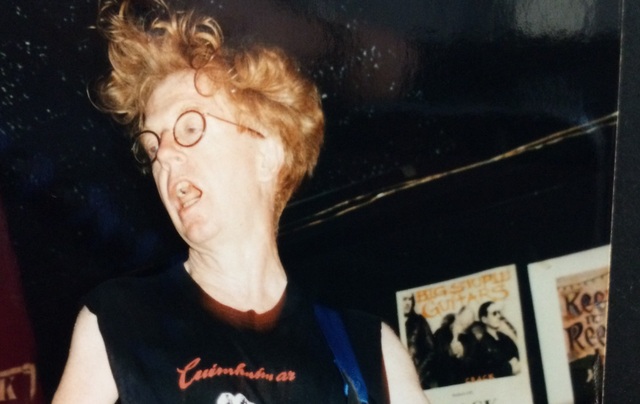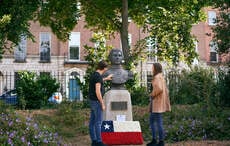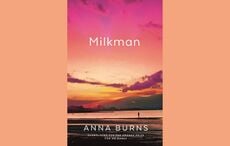We're back with Black 47's Larry Kirwan. Check with IrishCentral every second Sunday as we cover the history of the iconic band album by album.
In the coming weeks and months, Kirwan and IrishCentral will look back album by album on the history of Black 47 and their rise to fame. Below is the third installment of the series about the creation of "Fire of Freedom."
But first, an intro from Larry:
There’s nothing quite like being in a new band that’s “blowing up,” as they say, everyone wants a piece of you. You’d better have your feet firmly on the ground or it’s easy to get swept away.
I was somewhat prepared – back in Turner & Kirwan of Wexford days we had an FM radio hit with the album “Absolutely & Completely,” and as a novice playwright “Liverpool Fantasy” brought me a lot of attention.
But with Black 47 it was a whole different level. We had gone from being the toast of New York City to the “next big thing.” It was exhilarating, fun, and if you had time to stop and think - utterly fatiguing. There was little time for sleep, but who needed it.
And creatively we were on top of the world. Geoff Blythe was blowing up a storm on his saxophones, Chris Byrne was a sensation on pipes and rapping, Fred Parcells was using his vast repertoire of big band and jazz licks on trombone, Thomas Hamlin was spicing up the mix with African and Latin percussion, soon Dave Conrad would come aboard with his funky and melodic bass riffs, and I was adding punk drive and power chords to give the whole thing some bit of familiarity.
To write for such an ensemble was a songwriter’s dream – all I had to do was let my imagination and memory roam – the songs were there for the taking. I never gave a thought to making it, my only real ambition was that the songs would in some small way add to the poetry and magic of New York City. Bert Berns, Lou Reed, and The Ramones had done it – why couldn’t Black 47? We were on a roll!
Read the first two installments of this series here:
- Black 47 lead singer Larry Kirwan looks back on the band’s history: “Home of the Brave”
- Making Irish republican records when Sinn Féin were still pariahs - The creation of “Black 47”
Back in the Day 1993 – Fire of Freedom

Sinéad had blonde hair, a black beret and was a rebel. She hung out at our gigs, got drunk with us and laughed a lot. She wasn't married and had a baby at home. She was a can-do kind of person. One night she asked me what would move Black 47 to a new level? "Radio play," said I, with little or no hesitation. "Where do I start?" She replied. I told her about a guy named Vin Scelsa, gave her his address and a couple of 45s of Funky Ceili. The next week Vin started playing Funky Céilí.
That's one story. The other is that we were hired to play Greg Trooper's wedding and, in appreciation, Greg gave Vin the single. That's Vin's story and he's sticking to it! I think Sinéad's is more romantic. But such is life. (Another person would enter our lives at that wedding - Stewart Lerman, but later of him.)
Vin played the single constantly and, soon thereafter, the independent cd. We were off in a canter. The lines had already begun forming around the block for our gigs in Reilly's.
Roughly the same time, the music editor of Newsday happened to be walking by and was intrigued by the scene - lines outside for a band he'd never even heard of. He came in and a few days later, John Anderson was assigned to do a big piece on the band.
John came to all our gigs for a week and saw the tumult we were causing in the Bronx and Queens and the adoring crowds in Reilly's. He did a three-page article about the band and soon record companies were banging on the door.
I had had my fill of these people during the Major Thinkers days. (I've seen so many hearts and lives broken by the travails of the music business, but later for that too). Accordingly, when these "executives" would ask for a CD, I'd send them to the bar but tell them to have their money ready. I suppose that only added to the mystique.
For all their presence, they made little difference, at first. Back in their offices, none of them could put into words what kind of a scene we were causing or, even more importantly, how we could be marketed. One of them was different, however, his name was Pete Ganbarg and he was from EMI. I could tell he "got" the songs and the band. After his first visit, he knew all the words by heart. I felt he'd stick with us through hell and high water and he did. Still, EMI wasn't ready to commit.
And so the beat went on. Rolling Stone reviewed the independent CD and Vin Scelsa wrote a piece in Penthouse - we were fast becoming national. Now, remember, Steve Duggan had already sent us to play various Irish festivals in Boston, Chicago and San Francisco. It always amazed reviewers in these cities when they saw people sing along to songs that were not on the radio. God bless the grassroots!
Read more: "Go back to Cuba!" Larry Kirwan on his first trip there

Black 47.
Joe Strummer showed up one night and didn't leave for months. He usually just stood in the front row and bopped to the music. What a blast - The Man from the Clash groovin' to us! He told the booker for Wetlands that we had to play there and so began our relationship with that club that lasts to the present.
Matt Dillon was in most nights. He insisted that we appear in the movie "The Saint of Fort Washington." I remember so well the closing night party in Reilly's. Danny Glover standing on his stool, black power salute to James Connolly - Matt nursing a fractured foot on the bar. Celebrities came and went - most of them, nice people looking for a night out where they wouldn't be bothered. We were pretty cavalier about their presence. After all, the crowds were there to see us.
One day, Murad and Judy showed up. Judy was the sister of Elliot Roberts who had apparently managed everyone from Jesus on down. Elliot was, at this time, looking after Neil Young, Tracy Chapman and Ric Ocasek. He was based in LA but offered to manage us - with Murad and Judy handling things in New York.
Soon after, while on stage in Reilly's, I noticed a commotion in the crowd. It was hard not to take note of Ric Ocasek - tall, deathly pale and intense. However, when I joined him for a drink I was stunned to see that no one was paying any attention to him but to the leggy blonde on his arm. Where had I been? I had never heard of Paulina, his wife and world famous model.
Still, it made things easier to have a one on one with Ric. After a few compliments about the band and the information that the Cars had started in a similar dive in Boston, he got down to business: "I can make that independent CD of yours great."
That sounded intriguing, especially coming from someone who had sold 30 million records. "The problem is, I'm going away in a couple of weeks. If we're going to do this we've got to start right away. Think about it." Then Paulina turned to him, he melted into her arms (who wouldn't) and we got up to do our next set.
The next morning, Elliot was on the phone. "Well?" Says he, "do you want to do the CD with Ric?" I wasn't sure but then thought, "what the hell." We started later that night. It was a great experience - at least, for me. Ric was one of the most intelligent, insightful people I have ever met.
In the public eye, he has been painted into a corner by his enormous success with the Cars. But to me, he is a true artist - very inquisitive, a vast sensitivity and, despite or on account of all his success, thoroughly unafraid to fail. He was an amazing blend of humility, artistry and self-confidence, and then on top of all that, he was a real rock 'n roll star, in the flesh - with all the good and bad that bestows.

Larry Kirwan and Black 47.
His style of producing was to let you make the record, sit back on the couch and listen. And what ears he had. His studio was set in the basement of his townhouse in the Gramercy area. He rarely began recording before 5 pm and would continue well into the dawn and long after I had crept home, bamboozled with sound.
Whenever you faltered, he would make a suggestion, invariably right. Oftentimes, he would disappear upstairs with Paulina and leave you with his engineer and assistant, Heg.
He had an uncanny knack for knowing when things weren't right and he believed that records should be made with the minimum fuss. Probably his long years of trauma making records with Mutt Lange confirmed him in this.
After my departure at 4 or 5 am, he would work on. The next afternoon when I showed up, bright and bushy tailed, I would insist that Heg let me hear anything Ric had been messing with.
Thus was born the beautiful intro to Fanatic Heart on Fire of Freedom that he created with a Roland guitar synthesizer. Compare it with the more bare bones but still moving version on the independent CD- two ways of seeing things, each equally valid. Two snippets that he was about to discard were the pieces of Livin' in America which later became Fordham Road 8 am and Bainbridge Avenue 2 am.
Whenever he heard me do anything that sounded vaguely like the Cars he would beg me not to use it. "I'll be criticized for that," he would say. I told him to quit the paranoia! But he was right.
Critics hated him and blamed him for a number of my ideas. (One moron who writes for the NY Press even chastised him for the production of Black 47 Independent). He took it all stolidly. Such was the price of fame - perhaps, if you're married to a supermodel, have a lot of money, fame and success, these things don't matter - I wonder?) Still, hanging out with him was a lesson in life and I remember the time with great affection.
But back to the recording! We worked and remixed many of the songs from the independent CD and added, Fire of Freedom, Maria's Wedding, Our Lady of the Bronx and New York, NY 10009.
But time was catching up with us and Ric had a departure date. Sometimes we worked separately, in two studios, to get more done. He had such a clear idea of where a song should go. I had been agonizing with John Goldberger, the engineer, about the mix of Maria's Wedding. Ric swept in, an almost spectral figure and demanded the mix. When we told him our problems, he merely said, "play it!" And while we listened back, he moved 3 or 4 different faders.
By the time the song had finished, to our amazement and hurt pride, a new mix had been created. Without a word, he swept out of the studio, leaving us there staring at each other.

But it was a two way street with Ric. He loved our band dearly and delighted to be inspired himself. One of my most vivid memories is making the cries and screams for the intro to the Famine song, Black 47. I used, perhaps, six tracks to get those sounds, layering them and always keeping in mind the millions who had died.
Before doing a track, I would sit in his little vocal booth and summon up the spirits of those dead and discarded people. Track after track, I screamed, cried and moaned and each time I emerged, I would look at him. He would just stare back. Eventually, after losing all sense of time, he nodded. It was done and the three of us listened back wordlessly. He was a wonderful illustrator and always drew as he listened. When he left the room I snuck a look at his book. The page was empty.
That recording and mixing went by in a blur and, as usual, we continued to do gigs. One of which was an outrageously rowdy affair in Sam Maguires - that wonderful bucket of blood in the North Bronx. I remember rushing back downtown to the Record Plant where I had left John Goldberger mixing James Connolly. My ears were bleeding from Sam's and yet Connolly sounded magnificent - all the instruments blended together like some amazing fife and drum band. I heard Connolly on a compilation tape recently. It still sounds great. But all good things come to an end: Ric flew off to the Caribbean, Pete Ganbarg signed the band and so I brought the finished tapes up to EMI and … — Larry Kirwan
Reviews of Black 47: Fire of Freedom:
One of those rare "shot-heard-‘round the world" type of debuts where ten songs strung together might permanently put a band on the musical map. — CMJ
Although Black 47 speaks to its own community, it doesn't shut others out, as Mr. Kirwan's lyrics tell stories that resound beyond their local details. Rowdy, catchy and unrepentant, Black 47's songs give a forceful voice to a group from the margins. — The New York Times
This is the real thing: a raw, refreshing band, untainted and unafraid to play their hearts out for the sake of human rights and dignity, not to mention dancing, drinking and fucking – the sad and beautiful things that make life worth living all over the world. — Penthouse
Larry Kirwan isn't content to stand within the lyrical confines of standard pop songs – and that's what makes Black 47 so much fun. — Chicago Tribune
A blistering set of Celtic rock by turns raucous and tender, venomous and full of rejoicing harking back to a time not so long ago when rock ‘n roll was something more than commerce, fashion statements and self-service whining. — LA Times
Though there's an emerald lilt in Larry Kirwan's voice, his songs evoke Springsteen's America. Grade: A- — Entertainment Weekly
Read the first two installments of this series here:
- Black 47 lead singer Larry Kirwan looks back on the band’s history: “Home of the Brave”
- Making Irish republican records when Sinn Féin were still pariahs - The creation of “Black 47”
Do you have any photos of going to see Black 47 or any memories of their shows that you'd like to share with us? Send them to [email protected] with "Black 47" in the subject and we'll include them in Larry Kirwan's collected history.
This article was submitted to the IrishCentral contributors network by a member of the global Irish community. To become an IrishCentral contributor click here.




Comments